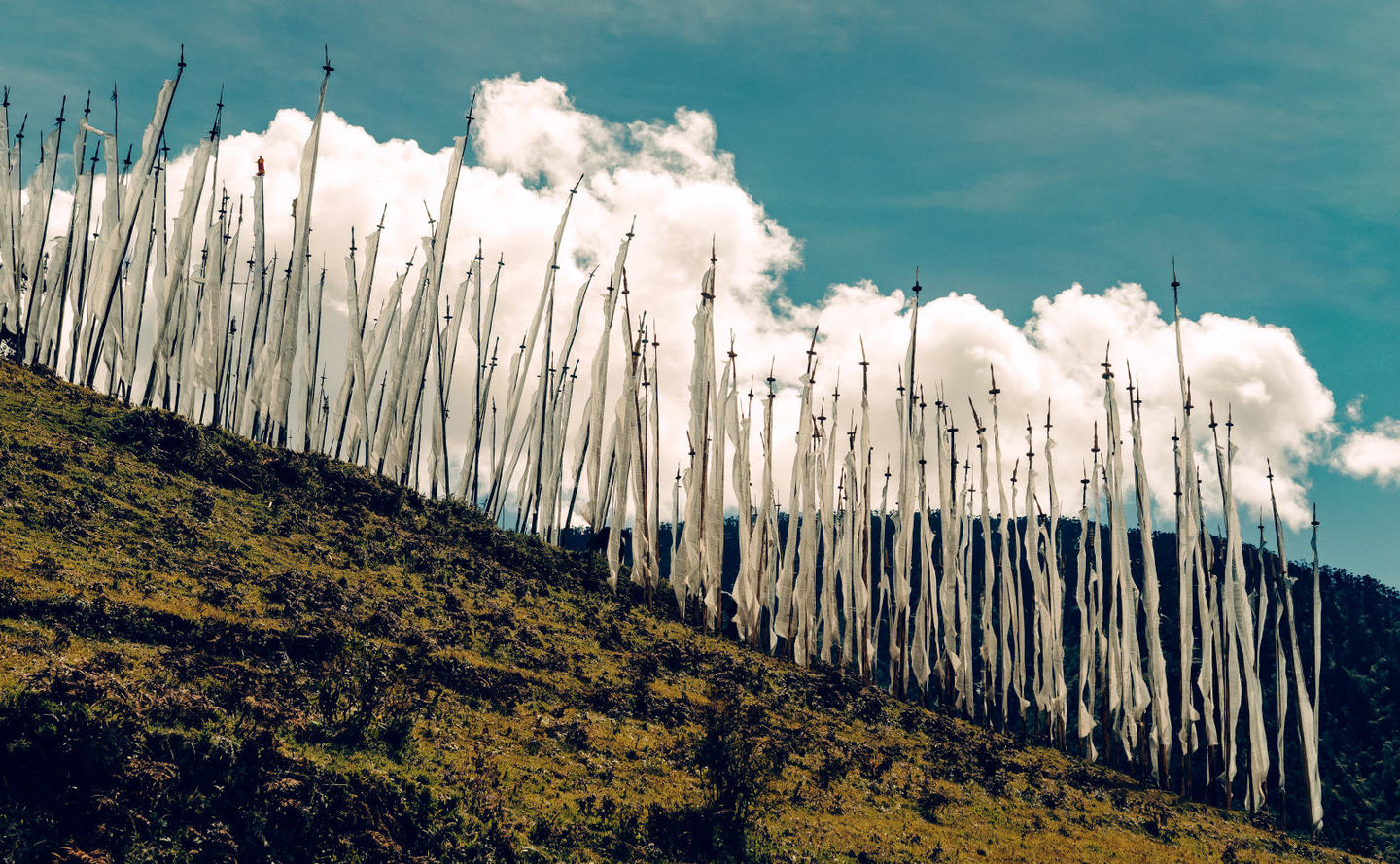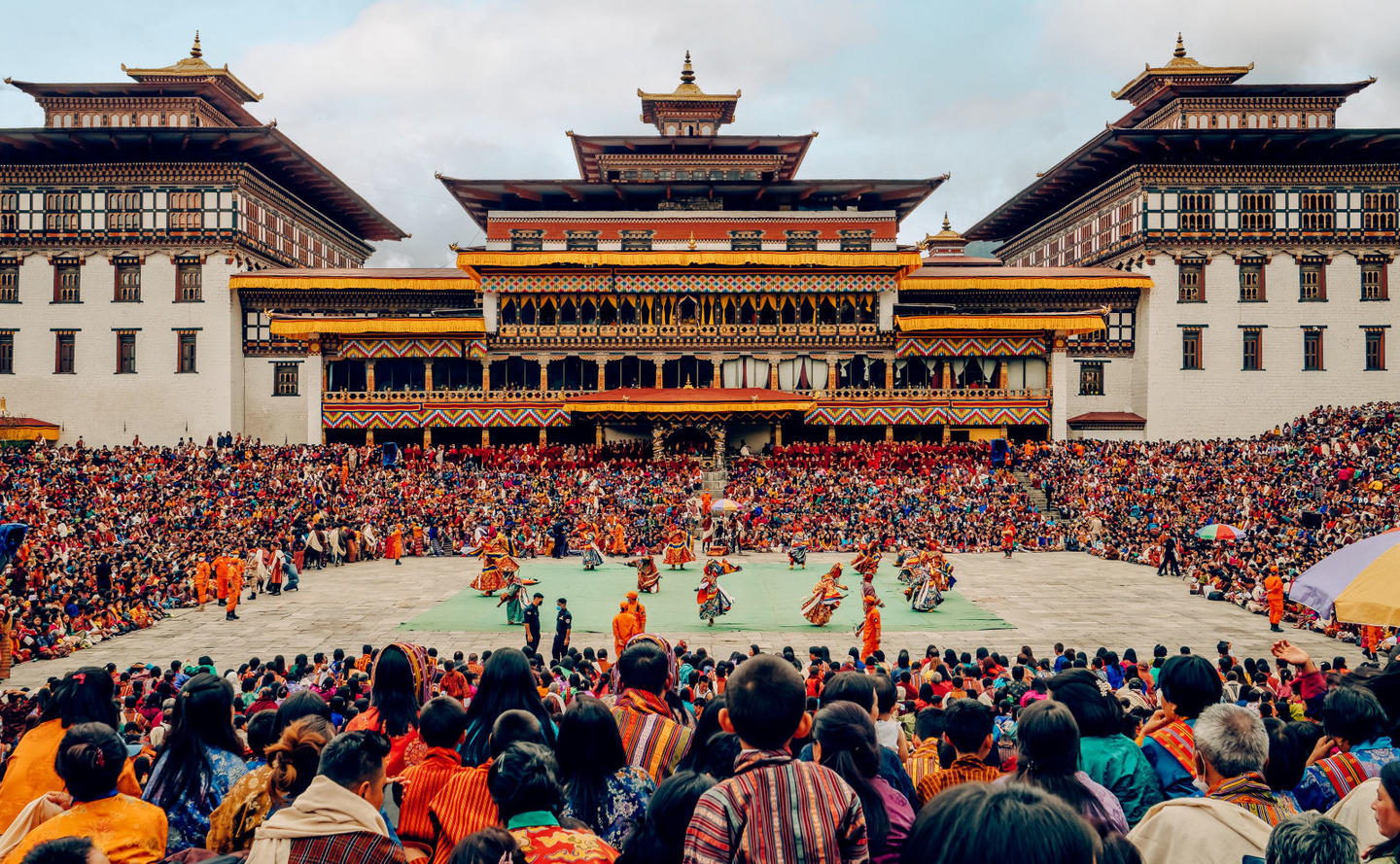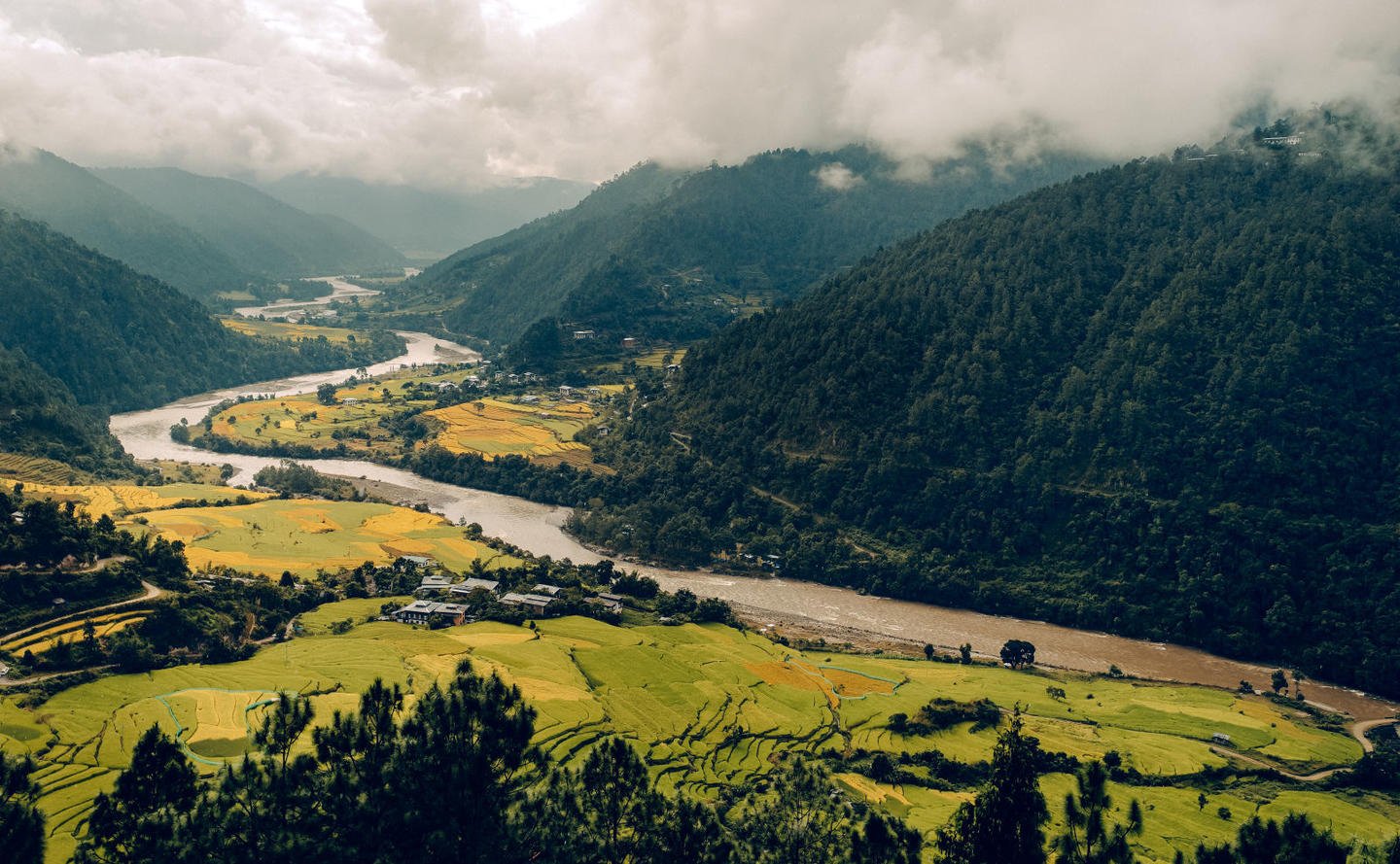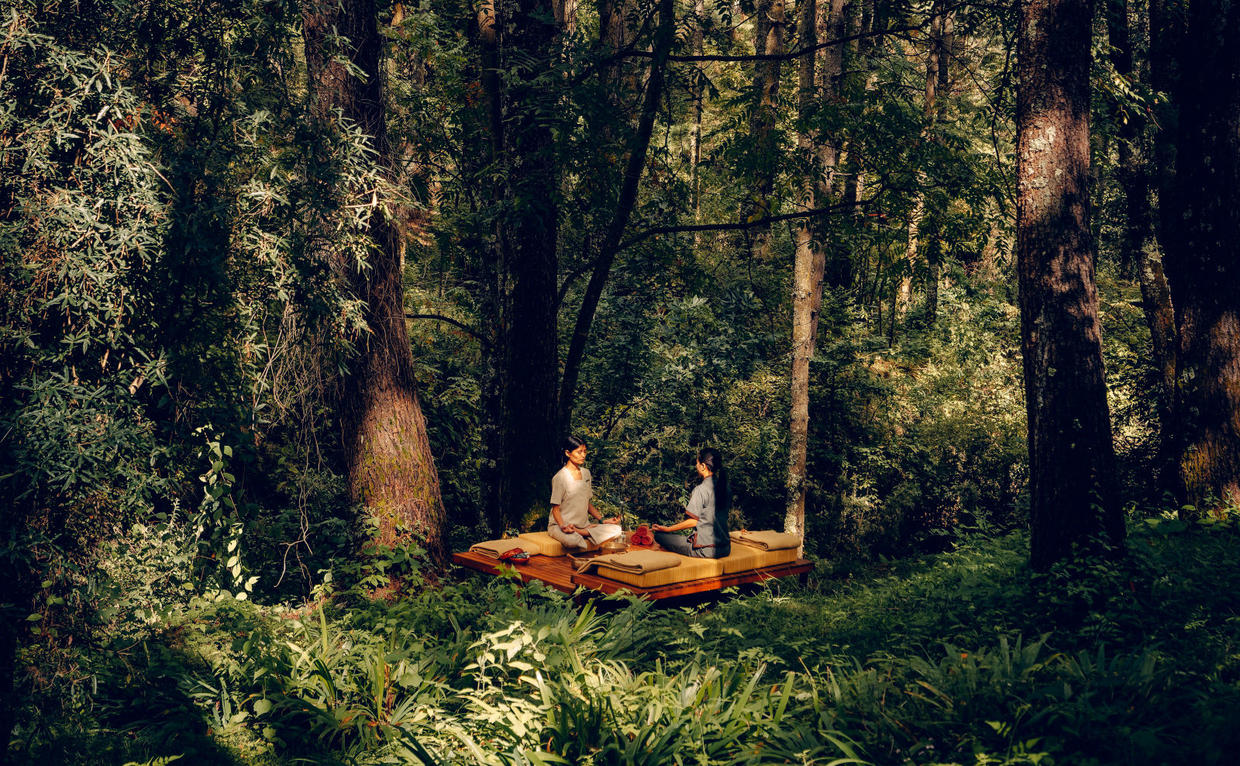Journeys Await
As the New Year approaches, Aman destinations across the globe await discovery.
Photography by Jérôme Galland
Words by Farhad Heydari
Amankora, Kingdom of Bhutan
Wooded glades studded with chir pines surround us, as I dial into the calming and reflective gurgle of a humble babbling brook. Though I can’t see it, the water’s entrancing resonance is mesmerising and renders me motionless. My wife is nonplussed: it’s the first time I’ve been silent all day – a day that began excitedly in Delhi and is coming to a ruminative close in the foothills of Motithang, just above Thimphu.

It’s almost dusk as we arrive at the first of five Amankora lodges in the Himalayan kingdom. A roaring fire is alight in the stone courtyard, encircled by half a dozen local women who are bewitching us with their dulcet chorus of folk songs. Reflection ensues, inspired by this golden magic-hour milieu – if this is what a few hours in Bhutan will do, how will we be changed after our 11-night journey across the country? The answer to that question is apparent before most visitors even touch down. Bhutan has eschewed the outside world for decades (televisions were only introduced in 1999), and few destinations still hold the promise of the truly authentic, the untouched, the unspoilt and the unique. Such is the lure of this Buddhist kingdom and the impression it has on your soul – to say nothing of its natural beauty, which is visible as our plane glides past rocky couloirs and gilded temples on its approach into Paro.


Amankora Thimphu’s 16-suite dzong-inspired base is perched beneath a copse on a ridge overlooking the capital. The 1.5-hour drive there is enriching: the roadways absent of Western advertisements, signs or logos. If, as T.S. Eliot put it, it’s the journey, not the arrival, that matters, our west-to-east sojourn signifies something substantial: singular experiences are still on offer in our ever-connected and increasingly homogeneous world.
Our journey will commence in two days’ time – before then, we embark on a rigorous two-hour hike through an ancient hidden trail to the remote Dodeydrak monastery. Tableaux of sequestered saffron-robed monks abound; as with the rest of their countrymen, these religious men practise Vajrayana Buddhism in modest conditions. We pass colourful prayer flags fluttering in the wind, led by our dedicated guide, Nima, who remains at our side for our entire adventure.

It is with Nima, and our courteous and abstemious driver, Karma, that we make for Punakha the next day. Before we get there, we summit the Dochula Pass (elevation 3,100 metres), where 108 memorial chortens or stupas were built to celebrate the eldest Queen Mother. We encounter the colourful annual Dochula Druk Wangyel festival, attended by members of the royal family and prime minister, Lyonchen Tshering Tobgay.*
My wife and I marvel at how accessible Tobgay is. He’s posing for photographs with well-wishers as he chats to us about our forthcoming drive and descent to Punakha – home, incontrovertibly, to the country’s most beautiful dzong. The Buddhist fortress constructed in 1637 sits proudly at the confluence of the Pho Chhu and Mo Chhu rivers. It is the latter that we cross upstream by suspension bridge to arrive at a second, bucolic Amankora lodge, a traditional Bhutanese farmhouse surrounded by paddy fields and rice terraces, crisscrossed by walking trails, in the heart of the valley.
"Few destinations still hold the promise of the truly authentic, the untouched, the unspoilt and the unique."

As guests who have opted to pinball between all the Aman lodges, a welcome sight for us is that each of the suites is arranged with a familiar layout. Amankora’s far-sighted designers have made sure that, while the setting and surroundings may change, there is continuity between the spacious wood-clad accommodations throughout the journey. Also consistent is the warm hospitality of the willing-to-please staff and the culinary oeuvre of the executive chef and his team.


The journey to our third Amankora stop, Gangtey Lodge, is the most memorable. The road from Wangdue Phodrang to Trongsa requires deft navigation by our driver, Karma. We are surrounded by alpine forests before embarking on a vertiginous climb to the remote Phobjikha glacial valley (altitude 3,000 metres).
Overwhelmed, yet again, by the solitude and spirituality of our environment, we pause at Gangtey Goemba monastery. Later, we gaze out at a 16th-century monastery as we soak in hot-stone-heated water in a field at twilight; our bath has been drawn by a local farmer whose potato shed will soon be lit with dozens of recycled candles to create an extraordinary location for our romantic dinner hosted by the Gangtey team.



Dominated by mountains, this landlocked country is striated with valleys and lowlands, carved by rivers fed by glacial melt and monsoon rains; settlements and villages make up the population centres. This includes our next stop, Bumthang, where the 16-suite Aman awaits adjacent to the Wangdicholing Palace. The town and the surrounding valley are known as the spiritual hub of the country, with no fewer than 29 temples and monasteries, including the ancient Jambay Lhakhang. After a couple of days of further walks, we board an internal flight for the 30-minute journey from the Choekhor Valley to the Paro Valley, our final destination.
For many, Amankora’s 24-room Paro Lodge is the launching-off point of a journey to the Land of the Thunder Dragon. For us, though, in the shadow of the snowcapped, 7,326-metre Mount Jomolhari, which straddles the border with Tibet, it is the grand finale. Thankfully, there are still several more remarkable hikes to be enjoyed, and this includes a 90-minute scramble to the country’s iconic attraction, the Tiger’s Nest. It is here at Paro Taktsang, as with many moments in this wondrous country, that it genuinely feels as though time stands still. Back at the lodge, we stop to process how precious our time has been here in the Eastern Himalayas. Fitting then, that Amankora Paro features an outdoor fire pit and a murmuring creek, one that meanders on a straw-covered forest floor. It’s a significant bookend to an enlightening journey that has been more edifying than any novel.
"Dominated by mountains, this landlocked country is striated with valleys and lowlands, carved by rivers fed by glacial melt and monsoon rains."

Farhad Heydari is an award-winning multimedia executive who has worked in every facet of the field (from radio and television to newspapers and magazines) for almost three decades. A leading authority in the worlds of luxury and lifestyle and travel and hospitality, he is the former International Executive Editor of Departures and Centurion and currently oversees NetJets’ quarterly magazine and Ultratravel, where he is a partner and Editor-in-Chief.
Jérôme Galland is a French photographer specializing in travel and architecture. Renowned for his story-telling and textured imagery that transport and inspire, his work has featured in publications such as Architectural Digest, while collaborations include luxury designers such as Hermès and Pierre Yovanovitch.
*Information correct at time of writing.

Encouraging circular journeys though the Kingdom, the Tourism Council of Bhutan recently announced a partial exemption from the daily mandatory Sustainable Development Fee (SDF) for visitors staying four nights or more. To best experience Bhutan’s captivating charm, Amankora’s reservations team is on hand to create personalised journeys that include a combination of its lodges and can also assist with all aspects of travel planning, including advising optimal length of stay based on the SDF incentive programme.